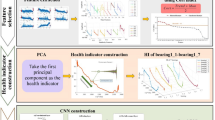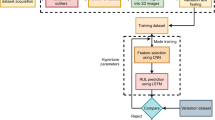Abstract
Real-time monitoring and rapid evaluation of bearing operating conditions, especially for the reliability evaluation and remaining useful life (RUL) prediction, are major challenges in the rotating machinery field. A two-dimensional (2-D) deep convolution neural network (CNN) is proposed for rapidly evaluating reliability and predicting RUL, in which a signal conversion method is proposed for converting the one-dimensional signal into the 2-D image to satisfy the input requirements of the 2-D CNN. Different activation functions are employed to implement the conversion of the input data to the output data for each layer of the network, and dropout is only adopted in the hidden layer to change the network structure to prevent overfitting. The maximum correlation entropy with regular terms is employed as the loss function of the model to obtain better training performance compared with the mean square error (MSE). Then, the rolling bearing degradation vibration data is applied to the proposed model to verify the accuracy and rapidity. The results show that the proposed method has good accuracy and fast calculation ability in bearing reliability evaluation and RUL prediction, especially, its time consumption is shorter than that by other deep learning networks.
Similar content being viewed by others
References
H. Shao et al., A novel method for intelligent fault diagnosis of rolling bearings using ensemble deep auto-encoders, Mechanical Systems and Signal Processing, 102 (2018) 278–297.
X. Jin et al., Anomaly detection and fault prognosis for bearings, IEEE Transactions on Instrumentation & Measurement, 65 (9) (2016) 2046–2054.
D. Wang and P. W. Tse, Prognostics of slurry pumps based on a moving-average wear degradation index and a general sequential Monte Carlo method, Mechanical Systems & Signal Processing, 56 (2015) 213–229.
B. Wang et al., An improved fusion prognostics method for remaining useful life prediction of bearings, IEEE International Conference on Prognostics and Health Management (2017) 18–24.
R. Zhao et al., Machine health monitoring using local feature-based gated recurrent unit networks, IEEE Transactions on Industrial Electronics, 65 (2) (2018) 1539–1548.
M. Cerrada et al., A review on data-driven fault severity assessment in rolling bearings, Mechanical Systems and Signal Processing, 99 (2018) 169–196.
Y. Lei et al., Machinery health prognostics: A systematic review from data acquisition to RUL prediction, Mechanical Systems and Signal Processing, 104 (2018) 799–834.
Y. Lecun, Y. Bengio and G. Hinton, Deep learning, Nature, 521 (7553) (2015) 436.
X. Yu et al., Rolling bearing fault diagnosis using modified LFDA and EMD with sensitive feature selection, IEEE Access, 6 (99) (2018) 3715–3730.
F. Riaz et al., EMD-based temporal and spectral features for the classification of EEG signals using supervised learning, IEEE Trans Neural Syst. Rehabil Eng., 24 (1) (2016) 28–35.
K. Javed et al., Enabling health monitoring approach based on vibration data for accurate prognostics, IEEE Transactions on Industrial Electronics, 62 (1) (2015) 647–656.
X. Chen et al., Remaining life prognostics of rolling bearing based on relative features and multivariable support vector machine, J. of Mechanical Engineering, 227 (12) (2013) 2849–2860.
F. Wang et al., Remaining life prediction of rolling bearing based on PCA and improved logistic regression model, J. of Vibroengineering, 18 (8) (2016) 5192–5203.
G. E. Hinton and R. R. Salakhutdinov, Reducing the dimensionality of data with neural networks, Science, 313 (5786) (2006) 504–507.
F. Jia et al., A neural network constructed by deep learning technique and its application to intelligent fault diagnosis of machines, Neurocomputing, 272 (2018) 619–628.
J. Sun, C. Yan and J. Wen, Intelligent bearing fault diagnosis method combining compressed data acquisition and deep learning, IEEE Transactions on Instrumentation and Measurement, 67 (1) (2018) 185–195.
H. Shao et al., Rolling bearing fault detection using continuous deep belief network with locally linear embedding, Computers in Industry, 96 (2018) 27–39.
F. Wang et al., An enhancement deep feature extraction method for bearing fault diagnosis based on kernel function and autoencoder, Shock and Vibration (2018) 1–12.
H. Shao et al., Intelligent fault diagnosis of rolling bearing using deep wavelet auto-encoder with extreme learning machine, Knowledge-Based Systems, 140 (2018) 1–14.
H. Ren et al., A novel adaptive fault detection methodology for complex system using deep belief networks and multiple models: A case study on cryogenic propellant loading system, Neurocomputing, 275 (2018) 2111–2125.
J. Tao, Y. Liu and D. Yang, Bearing fault diagnosis based on deep belief network and multisensor information fusion, Shock and Vibration, 2016 (7) (2016) 1–9.
H. Shao et al., Rolling bearing fault feature learning using improved convolutional deep belief network with compressed sensing, Mechanical Systems and Signal Processing, 100 (2018) 743–765.
X. Li, Q. Ding and J.-Q. Sun, Remaining useful life estimation in prognostics using deep convolution neural networks, Reliability Engineering & System Safety, 172 (2018) 1–11.
X. Guo, L. Chen and C. Shen, Hierarchical adaptive deep convolution neural network and its application to bearing fault diagnosis, Measurement, 93 (2016) 490–502.
L. Guo et al., Machinery health indicator construction based on convolutional neural networks considering trend burr, Neurocomputing, 292 (2018) 142–150.
L. Guo et al., Deep convolution feature learning for health indicator construction of bearings, 2017 Prognostics and System Health Management Conference (2017) 1–6.
W. Zhang et al., A deep convolutional neural network with new training methods for bearing fault diagnosis under noisy environment and different working load, Mechanical Systems and Signal Processing, 100 (2018) 439–453.
M. Xia et al., Fault diagnosis for rotating machinery using multiple sensors and convolutional neural networks, IEEE-ASME Transactions on Mechatronics, 23 (1) (2018) 101–110.
L. Ren et al., Prediction of bearing remaining useful life with deep convolution neural network, IEEE Access, 6 (99) (2018) 13041–13049.
A. Krizhevsky, I. Sutskever and G. E. Hinton, ImageNet classification with deep convolutional neural networks, International Conference on Neural Information Processing Systems (2012) 1097–1105.
K. Simonyan and A. Zisserman, Very deep convolutional networks for large-scale image recognition, Computer Science (2014).
C. Szegedy et al., Going deeper with convolutions, Proceedings of the IEEE Conference on Computer Vision and Pattern Recognition (2014) 1–9.
L. Wen et al., A new convolutional neural network based data-driven fault diagnosis method, IEEE Transactions on Industrial Electronics, 65 (7) (2018) 5990–5998.
N. Srivastava et al., Dropout: A simple way to prevent neural networks from overfitting, J. of Machine Learning Research, 15 (1) (2014) 1929–1958.
P. Nectoux et al., PRONOS-TIA: An experimental platform for bearings accelerated degradation tests, IEEE International Conference on Prognostics and Health Management (2012) 1–8.
L. Guo et al., A recurrent neural network based health indicator for remaining useful life prediction of bearings, Neurocomputing, 240 (2017) 98–109.
Y. Qian and R. Yan, Remaining useful life prediction of rolling bearings using an enhanced particle filter, IEEE Transactions on Instrumentation & Measurement, 64 (10) (2015) 2696–2707.
Acknowledgments
This work was supported by the National Natural Science Foundation of China (Grant Nos. 51605361, 51875432); and the Natural Science Basic Research Plan in Shaanxi Province of China (Grant No. 2018JQ5034).
Author information
Authors and Affiliations
Corresponding author
Additional information
Recommended by Associate Editor Gyuhae Park
Qibin Wang received his Ph.D. in Mechanical Engineering & Automation, Northeastern University, China, 2015. He is a lecturer at School of Mechano-Electronic Engineering, Xidian University, China. His interests are in mechanical vibration; gear system dynamic, mechanical reliability.
Bo Zhao is a master’s candidate of Mechano-Electronic Engineering, Xidian University, China. His interests include mechanical reliability and industrial big data.
Hongbo Ma received his Ph.D. at Xidian University, Xi’an, China, 2004. He is currently an Associate Professor of Mechano-Electronic Engineering, Xidian University, China. His current research interests include environmental testing and equipment reliability.
Jiantao Chang, who received his Ph.D. in Xidian University, Xi’an, China, 2013, is currently an Associate Professor of Mechano-Electronic Engineering, Xidian University, China. His current research interests include intelligent manufacturing and industrial big data.
Gang Mao is a master’s candidate in School of Mechano-Electronic Engineering, Xidian University, China. His interests include mechanical reliability and industrial big data.
Rights and permissions
About this article
Cite this article
Wang, Q., Zhao, B., Ma, H. et al. A method for rapidly evaluating reliability and predicting remaining useful life using two-dimensional convolutional neural network with signal conversion. J Mech Sci Technol 33, 2561–2571 (2019). https://doi.org/10.1007/s12206-019-0504-x
Received:
Revised:
Accepted:
Published:
Issue Date:
DOI: https://doi.org/10.1007/s12206-019-0504-x




